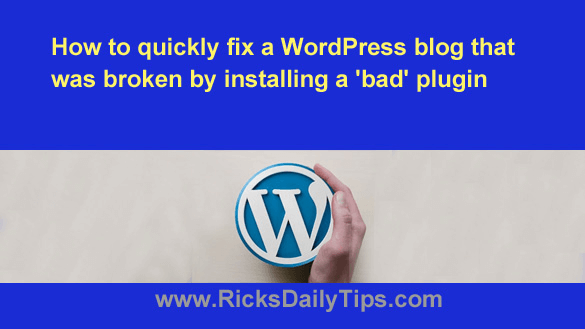 If you have a WordPress blog, chances are you will install a new plugin or update an existing one that “breaks” your blog at some point.
If you have a WordPress blog, chances are you will install a new plugin or update an existing one that “breaks” your blog at some point.
Trust me, it happens to most every blogger at one time or another.
I remember the first time it happened to me…
Immediately after I installed a new plugin the screen turned solid white and displayed an error message. I couldn’t even get previously viewed pages to load by pressing my browser’s “Back” button!
Worse still, I couldn’t remove the bad plugin via the WordPress Dashboard because the Dashboard wouldn’t load either!
My heart sunk because I just knew I had broken my blog for good.
As a total newbie, the only thing I knew to do was contact my web hosting company and ask them to restore my blog from a backup. They did, and my blog was back up and running in less than an hour.
I learned a valuable lesson that day. WordPress is a finicky platform, and the least little thing that goes wrong can give you that dreaded white screen of doom!
As I learned more about how WordPress works, I came to realize that most issues that rear their ugly heads are actually minor and can be easily fixed. Luckily, that usually applies when a bad plugin takes down your blog.
In most instances, you can quickly get a broken blog back up and running by simply deleting the bad plugin from the Plugins section of the Dashboard.
There will be times however when you won’t be able to delete the offending plugin from within the Dashboard because the Dashboard itself refuses to load in your web browser. That’s where a good FTP program comes into play.
Issues that arise with your WordPress installation shouldn’t affect your ability to FTP in to the server, so all you need to do is log in with your FTP program and use it to delete the bad plugin.
There are several good free FTP programs to choose from, but I use and recommend FileZilla because it’s so easy to configure and use.
To quickly fix a broken WordPress blog, simply use your FTP program to navigate to the wp-content/plugins directory of your WordPress installation, then remove the offending plugin by deleting its entire directory. That will get the blog back up and running immediately probably 98% of the time.
Note: An alternative to using an FTP program is to use the File Manager tool in your server’s Control Panel.
Now all of the above being said, there are rare instances where simply removing the bad plugin won’t repair a blog that was broken by installing a bad plugin.
If the plugin made changes to your blog’s .htaccess file or the WordPress database, you might have to restore the .htaccess file and/or the database from a backup. That’s why it’s important to always have a recent backup of your blog on hand!
There are several ways to back up your WordPress blog. You could always use a plugin like Backup Buddy or BackWPup, but I use and recommend the awesome VaultPress backup service.
With VaultPress, backups are created automatically in the background so you’ll never have to wonder if you have a current backup on hand. Even better, restoring your blog from a backup takes only a mouse click or two from within the VaultPress control panel!
VaultPress isn’t free, but plans start at just a few bucks per month, and it’s a real bargain for what I consider to be the closest thing you’ll find for creating daily bullet-proof backups of your WordPress blog.
I use VaultPress to back up all of my blogs, and I recommend it highly – especially if you earn money from your blog!).
Bottom line: You can usually get a blog that’s broken by a bad plugin back up and running in a jiffy by using an FTP program to simply delete the problem plugin.
If that fails however (and on rare occasions it might), you can always restore the blog from a backup so make sure you always have one at the ready.